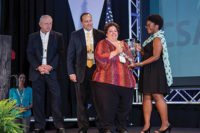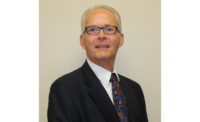The Making Of A Central Station


Baird Larson, vice president and director of technology for EMERgency24, said the christening of the new Underwriters Laboratories-listed central station in Des Plaines, Ill., will be the culmination of years of planning and months of action by his team of multi-disciplined staff engineers.
“The new EMERgency24 central station is unique in that our engineering staff designed and installed the operations and data center infrastructure, meaning the servers, telephony and data equipment — the hardware we use to run our operations. Using our in-house engineers gave us ultimate control over the end product and intimate knowledge of the infrastructure, which allows us tremendous flexibility for the future,” Larson explains. “The central station was purpose-built to enhance several aspects of EMERgency24’s internal and customer-facing operations, with a focus on increasing operational efficiency, flexibility and accommodating future growth.”
Larson’s narrative below describes the planning and processes that went into building a UL-listed central station in this unique manner.

SETTING GOALS
To tackle a project of this magnitude, the first step was to set our goals and then find the best location to help facilitate these. We chose 999 E. Touhy Ave. in Des Plaines, Ill., primarily for its robustness and ability to house our operations. Secondly, it’s a great location with several public transportation options; its proximity to both business and personal services is one of the best in the Chicago area.
Once we secured the space, the foremost requirements were to design a central station to satisfy our business needs and code requirements while minimizing environmental impact. That was a stated objective — to be the most efficient central station possible.
The next step was to create a space plan to satisfy UL 827 Central-Station Alarm Services and design components compliant with UL 1981 Central-Station Automation Systems. However, throughout the 15,000 square feet that is EM24 space, we went above and beyond all prevailing building and industry standards because there were many other considerations like functionality, occupant comfort and the marketing aspect of this facility.
From the day this project came about, I knew the biggest challenge we faced was moving telephony and the related services because we are dependent on several external carriers to deliver signals.
This obstacle would have existed regardless if we built a new central station at the old Chicago location or if we had leased space elsewhere, so that didn’t factor into our decision to relocate. It would have been a little easier to build in Chicago because we moved out of one rate center to another — from Chicago’s 773 area code to Des Plaines’ 847.
We needed to have a different type of service and receive permission to terminate 773 numbers in an 847 rate center even though the actual telephone numbers don’t matter any more. But since the telephony equipment is located in a different area, the carriers had to find a way to communicate with their own LECs, or Local Exchanges, from the long-distance carrier. We had to resolve this issue with multiple carriers for redundancy purposes and to ensure the operation of ancillary services.
The underlying factor for all telephony issues is that we cannot be down for one second. UL central stations do not have the luxury of shutting off services to move. We must be live 100 percent of the time.

UL REQUIREMENTS
There are two chief standards written to govern central station design and operation: UL 827 Central-Station Alarm Services and UL 1981 Central-Station Automation Systems.
UL 827 pertains to the basic structure of the building and covers physical plant requirements like demised walls, security and fire protection components. Within UL 827, other standards must be met including UL 1610 (Central-Station Burglar-Alarm Units), UL 1635 (Standard for Digital Alarm Communicator System Units) and UL 681 (Installation and Classification of Burglar and Holdup Alarm Systems).
UL 1981 sets the standards for the automation system, hardware and communication within the facility. It ties the whole operations end together in precise detail from degraded modes of operation and transient voltage protections to how the alarm receiving equipment is installed and methods for securing cabling systems. It also covers security access controls, the distance from operations to the automation system, power conditions and uninterruptible power supplies, which must be listed for UL 1778 or UL 1481.
To stay on top of all those requirements, we went through a comprehensive checklist, compared that to the existing infrastructure and determined what actions needed to be taken for compliance. One of the many good things about 999 E. Touhy Ave. is that it has Class-A building amenities with fire-retardant systems built-in. And it has a sprinkler system throughout, which is a tremendous asset.

ARCHITECTURAL PLANNING
Once we had our internal space plan finalized, a UL inspector performed a site visit to confirm our understanding of prevailing codes. I showed him the layout and we went over the space perimeter together. This was an important step because we needed the UL opinion before we could have an architect proceed with our broad-stroke space plan.
Another benefit is that the inspector gave us good ideas on how to save dollars while still meeting the code. We considered all of the ideas and implemented some, but our master plan was developed with an eye toward the future. For that reason, we went above and beyond design requirements in many areas.
We also built in some extras for marketing purposes and staff comfort. For example, we positioned the data center directly adjacent to the central station. The proximity allowed us to build a floor-to-ceiling glass viewing area that showcases both areas so alarm dealers can have a visual of how everything works together — our investment in people and technology. Plus, it just makes sense to have our 24/7-manned operations room next to our core communications systems, hardware and applications.
We also wanted to position the central station to overlook Lake Opeka to the north. Could we have arranged things more cost-effectively? Probably, but we chose to enhance our monitor work environment as we satisfied operational needs.
ENGINEERING REDUNDANCIES
A separate but simultaneous action to the architectural stage was the engineering process for electrical power, backup power, and mechanical and life-safety systems. When we moved to 999 E. Touhy Ave., there was an existing 5,000-amp common feed, but we needed isolated power so not to be affected by other electrical systems serving the remaining 140,000 square feet in the building.
Once isolated and after the main switchgear was retrofitted to accommodate two 275-KW power supplies, we brought the power up to a utility room that we built on the fifth floor. We then routed it back to ground level and trenched the parking lot to connect twin 275-KW generators. As a result we have an N+1 electrical system — meaning the configuration has at least one independent backup for each component to ensure system functionality in the event of a component failure. We did something unique to accomplish this: We separated the power so it doesn’t all go to one circuit; instead, there are four different panels so that any one circuit can fail and not affect the system.
The HVAC system consists of three 7.5-ton units directly above us on the rooftop: two to support the load on extreme-temperature days and one as an alternate. It has an interesting failover with a controlled damper system that automatically switches to run one or multiple units as needed. To protect the data center and meet redundancy needs, we also installed two state-of-the-art 10-ton cooling units that sit on top of our raised floors.
Basically, we are N+1 for all critical systems — even our receivers.
AVOIDING OVER-DESIGN
To design the electrical system, the first step was to calculate required power needed to manage peak loads and determine backup battery requirements for the various pieces of equipment. We’re required to do that by UL for all of our systems and they want to see the data.
All things considered, it’s not that big of a draw, so our designs reflected actual needs, plus the standard 30 percent to account for growth. However, many engineers want to over-design a system — so I had to present a strong case for the consulting engineering firm to sign off on the smaller electrical system we designed in-house.
The reason we don’t over-design is that systems are becoming more efficient. That is the leading green initiative in the computing industry today. Each generation of servers uses less and less power. When you factor in virtualization, which allows you to run multiple servers within a single case, the result is a smaller footprint that requires even less power.
Again, one of our objectives for this facility was to always use less where we could. It not only saves money, but we can further our green initiative. That’s important to EMERgency24.
In every area where it was possible, EMERgency24 elected to incorporate sustainable products and materials from local vendors, which cuts carbon emissions because there is less shipping involved. The company also chose to reuse existing furnishings where it was feasible. For the remaining space we made the conscious decision to purchase furniture that was refurbished or made of recycled materials.
Regarding fire suppression in the data center — and this is not a UL requirement — we decided to install an FM-200 clean agent extinguishing system capable of stopping a fire within seconds before it can do significant damage. The system uses a gaseous Halon alternative that has a rating of zero for ozone depletion potential and a global warming potential of one.
To conserve energy immediately, we installed efficient lighting fixtures that save more than $1,000 dollars each year. It takes 21 months to recoup the cost with rebates, but our energy use will continue to be low years beyond the break-even point.
The space EMERgency24 occupies also needed some new windows, so we chose Low-E insulated glass with a special coating to reflect infrared light. Low-E windows help stabilize room temperatures during the summer and winter. As windows are replaced, we will continue to use the same type, which has a thermal resistance, or R-value, of 3.5.
Because our operations are located on the top floor, we insulated the entire parapet interior that was previously bare concrete with no insulation value. The R-value for that is now between 14 and 22. We also receive the advantage of sound insulation — you would never know O’Hare Airport is directly across the expressway.
In the near future, to encourage the use of efficient transportation, we plan to implement solar and wind technologies to supply power for plug-in vehicle charging as well as for other non-critical company uses. We see all of these projects as opportunities to minimize our energy consumption.
THE CENTRAL STATION
The central station is configured with large, multi-functional smart stations designed for ergonomics and user efficiency. There is also ample room and wiring in place to increase capacity at any time.
The layout is dramatic — it focuses on security and the seriousness of the task at hand. We set it up amphitheater-style using a tiered and raised cement floor grid system. All monitors face forward with the focal point being a video wall that shows data such as calls in the queue, weather updates and national signal trends. Using standard video components tied to our systems gives us ultimate flexibility to show whatever we want. We can display as one screen or use them independently to direct the monitors’ attention to the most pertinent information at any given time.
There is a command center in back from which management and supervisors can see everything. The orientation of the central station adds to its security, too. No one can enter unseen as everyone faces the door up front. We implemented other security measures such as access control redundancy with biometrics, and a person has to go through several locked doors to get to the central station. On top of that, we have video surveillance everywhere. This is very secure space designed for optimum functionality.
Functionality was the primary goal for each work station that has three computer screens and a lot of space to work. The stations are solid-steel construction and other materials that will hold up for 24-hour use. We also have upright stations for monitors who prefer to stand. Soon we will experiment with three treadmill stations for staff members to get exercise during their shift. Those will run at just one mile per hour, so it will not impact breathing or speaking clarity whatsoever.
For monitor comfort, each station is equipped with forced air ducts so everyone can control their individual environment. That ties into the key component of the entire operation — the people. The objective and focus of the new central station was to create an atmosphere where people perform to their highest level. Giving monitors environmental control is important because they are the most important part of the entire system.
Looking for a reprint of this article?
From high-res PDFs to custom plaques, order your copy today!









